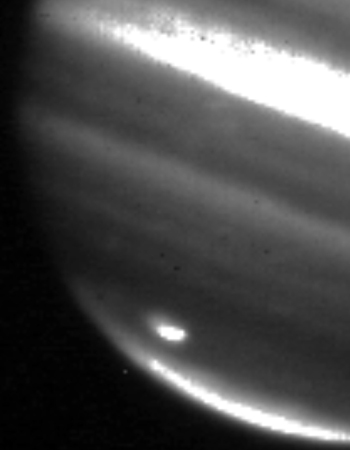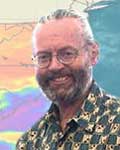The Lowdown on Jupiter’s Black Eye
Wednesday, July 29th, 2009
Glenn Orton
We’ve had such great feedback and comments to our earlier post about the recent impact at Jupiter that we wanted to give you more details, plus answer some questions. My name is Glenn Orton, a senior research scientist at JPL. My colleague and fellow JPL blogger Leigh Fletcher is on a well-deserved vacation for a bit, and he filled in for me while I was at a conference talking about another aspect of our research and the Jupiter impact last week.
I’ve been on Anthony Wesley’s email list (as I am for many in the amateur astronomy community) for some time, so it wasn’t happenstance that I was aware of his Jupiter observation. Anthony is the Australian-based amateur astronomer who alerted the world to this big impact. When we received news of his discovery, we immediately wanted to verify it with some of the sophisticated telescopes NASA uses. Having actively observed in both the visible and infrared during the Shoemaker-Levy-9 impacts in 1994, I was aware that a quick verification was possible by looking at a wavelength with lots of gaseous absorption, which suppresses light reflected from Jupiter’s deep clouds.

This image shows a large impact shown on the bottom left on Jupiter’s south polar region captured on July 20, 2009, by NASA’s Infrared Telescope Facility in Mauna Kea, Hawaii. Image credit: NASA/JPL/Infrared Telescope Facility
Luck was on our side. Several months before the impact, our JPL team had been awarded observing time on NASA’s Infrared Telescope Facility (IRTF) atop Mauna Kea in Hawaii. We had the midnight to 6 a.m. shift (from our Pasadena office, which meant we started work at 3 a.m.) so much of our observing time would take place before Jupiter rose over Australian skies. Another piece of luck is that Anthony’s “day job” involves software engineering so he was able to watch the same telescope instrument status and data screens as we were, while we did remote-style observing from the IRTF over the Internet. He would also be doing his own (now *very important*) post-impact observing. Weather was just as “iffy” over Mauna Kea as in Australia, so it was lucky for all of us that we could catch this event.
With Leigh, several JPL summer interns and me huddled at our side-by-side computers at JPL (one with instrument controls and one showing the data), and Anthony online from Australia, we got started. We knew the location of Anthony’s dark spot would be coming over Jupiter’s rising limb (edge) just as our allotted time was beginning. A near-infrared spectrometer was in the center of the telescope from the previous observer. Although it wasn’t our instrument of choice (we wanted images!), it has a very nice guide camera sensitive to the near infrared, so we used it rather than waiting for the 20-40 minute hiatus needed by the telescope operator to move it out of the way and put our preferred instrument in its place. This turned out to be a good decision because the very first image showed us something brighter than anyplace else on the planet — exactly where Anthony’s dark feature was located. For me, this totally clinched the case that this was an impact. Even better was the fact that Anthony was looking on in real time. We e-mailed him what was obvious - he was *definitely* the father of a new impact!
Right after this we collected data that may help us sort out any exotic components of the impactor or of Jupiter’s atmosphere and just how high the particulates have spread. Then we switched instruments to something at much longer wavelengths that told us the temperatures were higher, and that ammonia gas had probably been pushed up from Jupiter’s troposphere (the lower part of the atmosphere) and ejected into its stratosphere (higher up in the atmosphere). We finished up with our preferred (more versatile) near-infrared camera and ended up, pretty tired, at 9 a.m. (this was a midnight to 6 a.m. run in Hawaii, and in California we were three hours ahead). Then we took some of the screen shots we’d been making and used them to submit a press release. Another person had already alerted a clearinghouse for important astronomical bulletins, so that was another thing that was important but that we didn’t need to do.
Now some responses to posts:
Good post from Mike Salway who is another one of the cadre of the world’s talented Jupiter observers. I should note that, in fact, there aren’t all that many of us who track the time evolution of phenomena in the planets in the professional community, either (see the web pages for the International Outer Planet Watch: http://dawn.ucla.edu/IJW/).
Asim. Neither NASA nor JPL is capable of observing everything in the sky. There is a program to search for asteroids whose orbits will intersect the Earth’s, but not at Jupiter. In fact, it’s unlikely this object could have been seen, given that it may have been at most a half kilometer in size. For Shoemaker-Levy 9, we were both lucky and the disruption of the comets left a lot of very shiny material around it which made it easier to see.
Denise. It hit quite a bit further south than the Shoemaker-Levy 9 fragments, almost at 60 deg S latitude.
Patrick, Jim, BobK. I suspect that the only link between this and the SL9 fragments is the voracious appetite of Jupiter, the great gravitational vacuum cleaner in that part of the solar system! SL9 fragments impacted from the south; this was from the east.
























